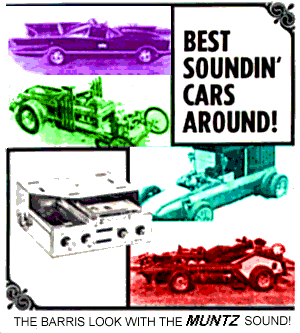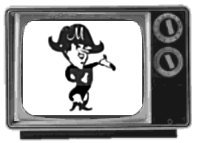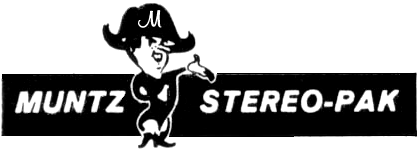 back
to 4-track Page
back
to 4-track PageWhen I say the name "Earl Muntz", what comes to mind? Unless you lived in California in the 1940's or 50's, or you are a true student of pop culture, your most likely response is "Nothing". Too bad, because Earl "Madman" Muntz was one of the most interesting practitioners of the art of hucksterism that America has ever known. He was a self-taught engineer, an outrageous personality, and the inventor of the Muntz Stereo-Pak 4-track system, the direct ancestor of our beloved 8-track.
Like Bill Lear, the father of 8-track, Muntz was a high school dropout and a tinkerer. Like Lear, Muntz's tinkering led to some great machines. Lear had his Lear Jet and Muntz created the Muntz Jet, a souped-up sportscar which sold for $5,500 (big, big bucks in the early 1950's). Like Lear, Muntz was an audio nut. According to Billboard, he developed the first known car stereo - a 110-volt system that was modified to run on the car's own battery to avoid the risk of electrocution.
Earl Muntz started out as a used-car salesman. Before long, he began appearing on radio and television to promote his cars, and that's when his real notoriety began. Muntz is usually credited with starting the "this guy's insane, come take advantage of his crazy prices" school of salesmanship. In some of his commercials, he would promise to take a sledgehammer and smash a car on television if the car wasn't sold that day. He screamed and hollered and loudly proclaimed "I buy them retail and sell 'em wholesale - it's more fun that way!". Earl Muntz would do anything for publicity. During the height of the McCarthy era, he contemplated joining the Communist Party in order to get more exposure. He dressed up in red longjohns and a Napoleon hat, probably both as a caricature of the cliche of crazy people with Napoleonic delusions and as a representation of his plans to conquer the market. And conquer he did. Muntz made $72 million in the car business, and in the process he became a celebrity. Bob Hope and Jack Benny used his name as a punch line, tour buses regularly stopped at his lot, and in 1943, pranksters at the Rose Bowl spelled out his name at halftime.
 Muntz went from cars to televisions (he
named his daughter Tee Vee, although she is usually known as
Tina) and distinguished himself in this field both by making a
fortune and by skimping on components in order to keep his prices
low. Engineers of a certain age still refer to the practice of
"Muntzing", which means reducing something to the
absolute minimum number of parts it requires in order to run.
Muntz was famous for walking up to his engineer's workbenches and
snipping out capacitors that he considered to be
"extra" (the Muntz of legend always carried a pair of
insulated nippers for just such occasions).
Muntz went from cars to televisions (he
named his daughter Tee Vee, although she is usually known as
Tina) and distinguished himself in this field both by making a
fortune and by skimping on components in order to keep his prices
low. Engineers of a certain age still refer to the practice of
"Muntzing", which means reducing something to the
absolute minimum number of parts it requires in order to run.
Muntz was famous for walking up to his engineer's workbenches and
snipping out capacitors that he considered to be
"extra" (the Muntz of legend always carried a pair of
insulated nippers for just such occasions).

Car audio was the next world Muntz set out to conquer. In the early 60's, he started producing the Muntz Stereo-Pak, a 4-track system. Bill Lear took a ride in a car with a Muntz stereo in 1963. He was so impressed that he immediately drove over to see Earl Muntz and signed a distribution deal. Lear installed Muntz players in some Lear Jets, and he began taking the players apart and finding ways to improve upon their design. And so the 8-track was born.
Earl Muntz died in 1987. At the time of his death, he had shifted the focus of his business to cellular phones. There were many other schemes in between - projection T.V.'s and aluminum houses, to name just two. Muntz was married seven times, and until the end, he drove a custom Lincoln Continental with a TV built into the dashboard (he claimed it helped him to drive better). The Muntz name lives on beyond his death. There are three "Muntz Stereo" stores listed in the California telephone books and one "Muntz Electronics".
William Golden, a man who worked for Muntz in the 1960's, has written me two very interesting e-mails. Here they are.
Back to [CONTENTS]